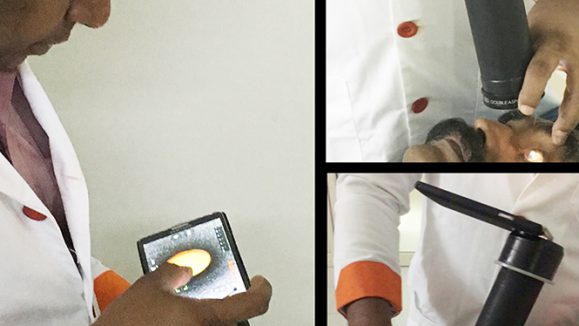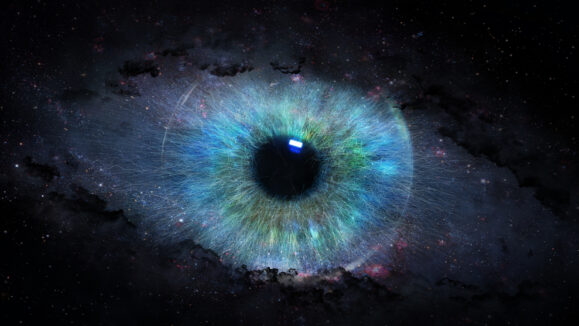While the COVID-19 pandemic has reinforced the importance of remote monitoring and telemedicine for progressive ophthalmic diseases, the technology — and need — has existed for quite some time.
This is especially true for conditions that impact sight and have no cure, like age-related macular degeneration (AMD), which is a leading cause of visual impairment and severe vision loss in industrialized countries. In its advanced stages, AMD comes in two forms: wet and dry, both of which lead to vision loss. Wet AMD will develop in 10 to 15 percent of people with intermediate AMD and often the progression from dry to wet is not caught until vision loss has already occurred.1
Because baseline vision is a strong determinant of long-term vision, early detection of wet AMD can be crucial to achieving favorable therapeutic outcomes. Further, a recent cost-utility analysis reported that early treatment was 138 to 149 percent more cost-effective than late treatment2 — and this, combined with better outcomes, cements the need for early detection.
Out with the Old, In with the New

If you just saved some vision, you’d dance too.
The standard of care for AMD monitoring includes routine office visits and using an Amsler grid. However, the grid does not always provide early detection — meaning, when distortion is noticed on the grid, vision may have already been lost. In fact, wet AMD may be present for 6 to 12 months before detection and treatment.3 And although the Amsler grid has long been used for home monitoring, its efficacy can be compromised by patients’ perception of distortions and compliance. In fact, no well-designed clinical trial has shown that the Amsler grid is effective in detecting wet AMD in patients with good visual acuity (VA).2
And of course now, during a global pandemic, routine office visits are no longer an option for many people — either out of fear of contracting COVID-19 or due to office closures and other regulations. This is precisely where home monitoring can have a big impact.
In fact, a recent large-scale data analysis of 3.2 million tests, titled Real-World Performance of a Self-Operated Home Monitoring System for Early Detection of Neovascular Age-Related Macular Degeneration2 found that remote monitoring using the ForeseeHome (Notal Vision, Manassas, Virginia, USA) provided significant benefits by helping to detect wet AMD earlier and with better visual acuity. This has been found to have a positive impact on long-term anti-VEGF treatment visual outcomes.
This retrospective analysis from the Notal Vision Diagnostic Clinic, the medical provider of the ForeseeHome remote monitoring program, included 306 eyes that converted to wet AMD between October 2009 and September 2018. Of the 306 eyes with confirmed disease progression, 211 (69%) were identified following the at-home system alert, and the remaining 95 (31%) were identified during a routine or a symptom-driven visit.
The authors found that functional vision (of 20/40 or better) at conversion was maintained in 81% of patients in the real-world ForeseeHome cohort compared to only 34% in the IRIS® Registry real-world data using standard of care. This is a substantial difference and clearly illustrates the benefits of home monitoring.
Dr. Allen C. Ho was the study’s principal author. He said: “This real-world data analysis confirms that the use of ForeseeHome provides a significant benefit to patients as a means of increasing the early detection of wet AMD when vision is good.
“Earlier detection of wet AMD with this FDA-cleared device is a strong predictor of better vision over time with current anti-VEGF therapy. ForeseeHome can be a useful strategy to monitor at-risk intermediate AMD and help protect vision. The era of at-home digital monitoring of medical conditions including AMD continues to evolve and improve for patient benefit,” continued Dr. Ho, who is also director of Retina Research of Wills Eye Hospital and professor of ophthalmology at the Kimmel School of Medicine at Thomas Jefferson University in Philadelphia, Pennsylvania, USA.
This was echoed by another study author, Dr. Jeffrey Heier, who serves as director of the Vitreoretinal Service and director of Retina Research at Ophthalmic Consultants of Boston (Massachusetts, USA): “Artificial-intelligence enabled home monitoring between office visits could be extremely helpful in early detection of conversion and the ForeseeHome program is a meaningful complement to the at-risk dry AMD patient’s care plan.”
The authors added that in today’s climate, the ability to detect AMD conversion — while limiting potential exposure to COVID-19 — certainly adds even more value. “It may drive physicians, patients, and their families to request access, gain benefit from the expected performance, and drive a large-scale improvement in the quality of life of this growing population,” concluded Dr. Ho and authors.
More Device Details
The Notal Vision Diagnostic Clinic includes patient engagement, compliance monitoring and alert generation services; ForeseeHome is part of this comprehensive monitoring program by Notal Vision.
To use the device, patients do a short, daily test on the device. Results are automatically transmitted to the Diagnostic Clinic and when a statistically significant change in visual distortion is detected, the referring physician is alerted to determine the best course of action.
“The newly published real-word data shows that the performance of the ForeseeHome program resembles the findings from the randomized controlled AREDS2-HOME study, which ultimately led to Medicare coverage,” said Kester Nahen, PhD, CEO of Notal Vision. “The Notal Vision Diagnostic Clinic is proud to partner with physicians by providing complementary care for their patients.”
References:
- Waugh N, Loveman E, Colquitt J, et al. Treatments for dry age-related macular degeneration and Stargardt disease: a systematic review. Southampton (UK): NIHR Journals Library; 2018 May. (Health Technology Assessment, No. 22.27.) Chapter 1, Introduction to age-related macular degeneration. Available from: https://www.ncbi.nlm.nih.gov/books/NBK500483/.
- Ho AC, Heier JS, Holekamp NM, et al. Real-World Performance of a Self-Operated Home Monitoring System for Early Detection of Neovascular Age-Related Macular Degeneration. J Clin Med. 2021;10(7):1355.
- Ho AC, Albini TA, Brown DM, Boyer DS, Regillo CD, Heier JS. The potential importance of detection of neovascular age-related macular degeneration when visual acuity is relatively good. JAMA Ophthalmol. 2017;135(3):268-273.



